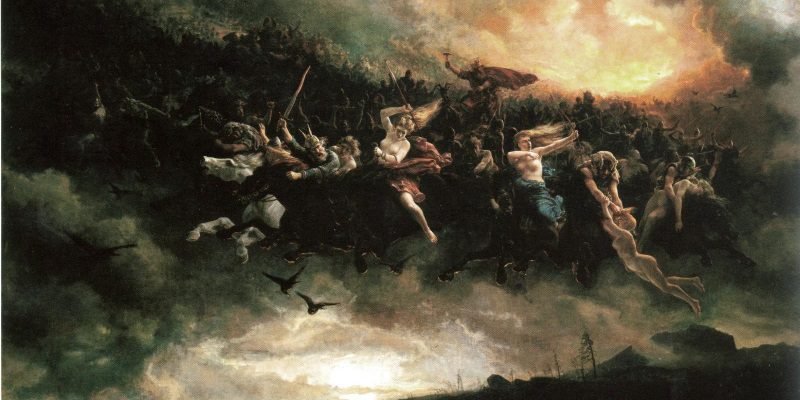Fey Huntsmen and Leashed Terrors

A few weeks ago, I wrote about fey knights and the general dearth of worthy fey opponents in the 5e Monster Manual. This week, I present the fey huntsmen that lead the Wild Hunt and their beasts, the leashed terrors. If you need a foundation in the mythology of the Wild Hunt, Wikipedia is here for you. I’m going beyond the core of that myth to propose game-able goals for the Wild Hunt and Archfey that might control them. Because of the themes of fear and death, I’m mostly associating the Wild Hunt with the Unseelie or Winter Court, but in other settings I’ve seen it presented as something closer to an independent force of nature, separate from the Courts.
Fey Chivalry | Fey Huntsmen and Leashed Terrors | A Visit to the Shadowfell – Shadar-Kai and More
Fey Huntsmen
The fey huntsmen who carry out the Wild Hunt are lesser servants of an Archfey, usually one of the Winter Court. They pursue prey in the material world and in the Feywild, sometimes shifting back and forth between the two in an eyeblink to gain ground in the chase. They always return to the Feywild at the rising of the sun.
Fey huntsmen exult in the joy of the hunt and the terror of their chosen prey. They run or ride at night, when mortals quake in fear behind locked doors. Many fey huntsmen carry trophies of their most notable kills, or else bear hunting horns of power and distinction.
Some few huntsmen serve the Summer Court, and hunt those who have particularly offended their Queen. Often this includes the undead, owing to an ancient grudge between the Queen of the Fey and the first and darkest lord of the undead.
Unearthly Cavalcade. Fey huntsmen and their leashed terrors generate a cacophony of horns, baying, thundering hooves, jangling of tack, and the like far in excess of their numbers, as they are accompanied by many more of their kind just on the other side of the veil between the material world and the Feywild.
Portents of Doom. Every culture that knows anything of the Wild Hunt speaks of it as a portent of doom, perhaps even able to snatch away the souls of those who hear its passing. Certainly the Wild Hunt is most active when the Archfey turn their attention toward mortals, and that is seldom to the benefit of the latter. If you find yourself the quarry of the Wild Hunt, it is said that they cannot pursue you onto holy ground. Survive until morning, and they may forget about you the following night.
FEY HUNTSMANLarge fey, chaotic evil |
|||||
|---|---|---|---|---|---|
| Armor Class 16 (hide armor) Hit Points 204 (24d10 + 72) Speed 40 ft. |
|||||
| STR | DEX | CON | INT | WIS | CHA |
| 18 (+4) | 12 (+1) | 16 (+3) | 10 (+0) | 14 (+2) | 14 (+2) |
| Damage Vulnerabilities bludgeoning, piercing, or slashing damage from weapons made of cold iron Skills Animal Handling +6, Perception +6, Survival +6 Senses blindsight 10 ft., darkvision 120 ft., passive Perception 12 Languages Common, Giant, Sylvan Challenge 9 (5,000 XP) |
|||||
For each fey huntsman, choose one of the following traits:
|
|||||
Actions
|
|||||
A trophy of the great beast or horn of the wild hunt is almost always ruined in the course of a battle, or sundered upon the death of its bearer. One who proved true courage, enough to stir the heart of even a merciless and cruel fey huntsman, might be rewarded with such an item from the huntsman’s own hand. They are wondrous items that require attunement. Please note that the trophy of the great beast is not balanced for PC use, and you will want to consider adjusting its effect, while the horn of the wild hunt is useless to most PCs and should have its effect changed to something reasonable.
Leashed Terrors
The leashed terrors that serve fey huntsmen as trackers, or that guard the palaces of Unseelie nobles, were once mortals – human, dwarven, or any other kind of humanoid. The glamour of the Unseelie causes them to take the shape of their own darkest terrors. (Those whose darkest terrors are ill-suited to hunting or war are given… other work.)
This fey magic is bound to them in their collars, clasped about their necks. This clasp is vulnerable to determined effort, but the leashed terrors are sure to punish those who fail in the attempt.
Many leashed terrors look vaguely canine or lupine, while others take the shapes of any kind of great predator, or even a nightmarish mix of features that have never existed on a single creature in nature.
Always Hungry. Fey huntsmen feed their leashed terrors only enough that they still feel the pangs of their hunger, for they want them to be as aggressive as possible. The leash and collar make sure that the terrors come quickly to heel.
The Mortal Within. It is still possible to free the leashed terrors from the magic that holds them. Many of them crumble to dust the moment they are released, as the weight of too many centuries destroys them. The rest will surely struggle with the memories of their time as a beast of the Wild Hunt.
LEASHED TERRORMedium monstrosity, chaotic evil |
|||||
|---|---|---|---|---|---|
| Armor Class 14 (natural armor) Hit Points 117 (18d8 + 36) Speed 40 ft. |
|||||
| STR | DEX | CON | INT | WIS | CHA |
| 16 (+3) | 12 (+1) | 14 (+2) | 6 (-2) | 12 (+1) | 6 (-2) |
| Condition Immunities frightened Senses blindsight 10 ft., darkvision 60 ft., passive Perception 11 Languages understands Common and Sylvan but cannot speak Challenge 4 (1,100 XP) |
|||||
| Transformed Mortal. When a leashed terror’s current hit points are less than or equal to half of its maximum hit points, the clasp of its collar becomes accessible. A successful Dexterity (thieves’ tools) check against DC 14 opens the clasp, transforming the leashed terror back to its original form. On a failed check, the leashed terror can spend its reaction to make an attack on the creature that attempted to unlock its clasp.
Keen Smell. The leashed terror has advantage on Wisdom (Perception) checks that rely on smell. Pounce. If the leashed terror moves at least 20 feet straight toward a creature and then hits it with a claw attack on the same turn, the target must succeed a DC 14 Strength saving throw or be knocked prone. If the target is prone, the leashed terror can make one bite attack against it as a bonus action. |
|||||
Actions
|
|||||
If a PC were to fall victim to the Wild Hunt, it is possible that the fey huntsmen would not feed him or her to the leashed terrors, but instead bind a collar around the PC’s neck. A PC who has become a leashed terror might be freed by another PC, traded between Archfey, or even free herself, if she were presented with things that strongly reminded her of her mortality. Few NPCs have the strength of character to achieve such a thing.
The Goals of the Wild Hunt
What motivates the fey huntsmen and the Wild Hunt? Here are a few ideas.
- The Wild Hunt is a sport, an amusement for fey nobles suffering from ennui. The “fey huntsman” is nothing more than a kind of mask that a noble can wear. Perhaps the fey knight you crossed swords with last month is the same creature, in a different guise, as the fey huntsman that now pursues you.
- The Archfey who commands the hunt is under a geas that prevents him from setting foot on hallowed ground. The purpose of the Wild Hunt is to collar and transform as many blasphemers, heretics, and apostates as possible, to terrify priests into abandoning their holy places.
- By making the common people too frightened to look out their windows at night, lest the Wild Hunt steal their souls, the fey can perform their ancient rites unseen, increasing their sway over the world of mortals.
- It isn’t that the fey feed upon the fear they inspire; rather, they thrive upon the ritualized devotion that is said to ward them away, much as gods do with those who pray and praise them.
- It is an ancient game between the Queen of Summer and the Queen of Winter: is love stronger than fear? Is there any difference between the two? The Wild Hunt is but one way that the Queen of Winter proves her argument – her huntsmen especially prey on lovers at a tryst. If love were stronger than fear, surely they would not flee and cower so delightfully…
- The King of the Winter Court has been lost, lo these countless aeons, and the Queen sent the Wild Hunt to search every hill and vale, village and hamlet, to find him. They have gotten a bit off task, but it’s ever so much fun to toy with mortals. After all, the King may not be getting any younger, but he’s not getting any older, either.
Conclusion
These two creatures should pair together pretty well. I miss the lock-and-key way that 4e encounter design worked, where one creature’s abilities fit perfectly with those of another creature that it made good story sense to pair them with. I’ve tried to do that here, especially in the fey huntsman’s spear attack. I could have been more precise about calculating appropriate amounts of damage and CR for these creatures, but in my own game I try not to sweat it too much, and I hope you’ll see it the same way.



